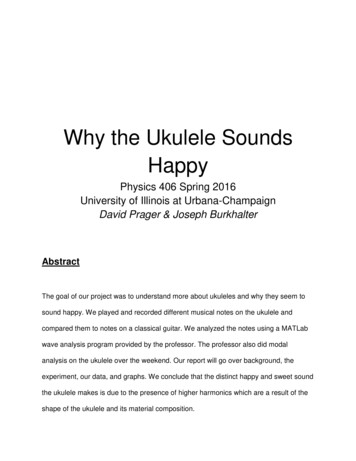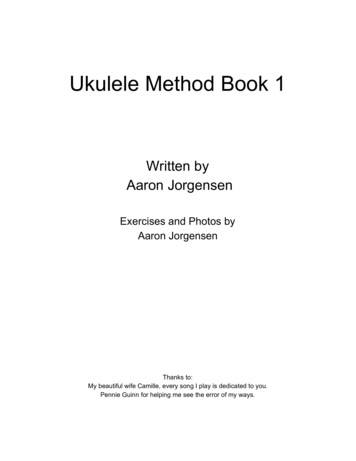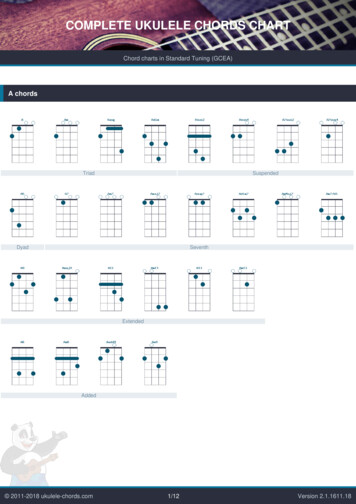
Transcription
Why the Ukulele SoundsHappyPhysics 406 Spring 2016University of Illinois at Urbana-ChampaignDavid Prager & Joseph BurkhalterAbstractThe goal of our project was to understand more about ukuleles and why they seem tosound happy. We played and recorded different musical notes on the ukulele andcompared them to notes on a classical guitar. We analyzed the notes using a MATLabwave analysis program provided by the professor. The professor also did modalanalysis on the ukulele over the weekend. Our report will go over background, theexperiment, our data, and graphs. We conclude that the distinct happy and sweet soundthe ukulele makes is due to the presence of higher harmonics which are a result of theshape of the ukulele and its material composition.
Introduction / BackgroundTaken from Lecture Notes “Tone Quality - Timbre”A pure note has one distinct frequency, whereas a complex note is asuperposition of notes that have different frequencies, phases, and amplitudes. Acomplex note played on a stringed instrument will have a dominant frequency called thefundamental frequency. Other notes heard in the complex note will be integers multiplesof the fundamental frequency are are called harmonics. Most notes produced bymusical instruments, including stringed instruments like the ukulele and classical guitar,are complex notes. Using Fourier analysis, the complex tone can be broken down intoits component waveforms and by analyzing the properties of the different harmonics, aperson can analytically understand the properties of musical notes and how theyconstructively and destructively interfere with each other and why the same note playedby different instruments can still sound very different. Notes that do not have a strongpresence of higher harmonics are thought to sound more ‘mellow,’ while notes that havehigher harmonics have a ‘bright’ sound.The harmonic composition of a tone is related the specific instrument.Differences in the material or dimensions of the instrument result in changes to theharmonics. The musician playing the instrument can also influence the harmonics in theway they play the specific note.Specifically for stringed instruments, the farther the string is plucked from thecenter, the higher the harmonic content. Steel strings also produce notably higher
harmonics than those of nylon. Another stringed instrument property that contributes tothe harmonics is the sound hole and cavity. The note produced by plucking the stringenters the sound cavity which has certain resonances. Certain note harmonics willresonant with the sound cavity and be amplified, giving the overall note composition adifferent harmonic content than without the sound cavity.Experimental Setup and ApparatusWe used a Lanikai Soprano Ukulele and a Yamaha Classical Guitar Model CG150SA. We started off by recording several different ukulele notes.The ukulele has fourstrings that when in tune and played open, without any fingers touching the strings,correspond to the notes A, E, C, and G. Additional notes were played and recorded bythe ukulele by shorting the strings wavelength by pressing a string against the fret onthe backboard. When recording the notes, the strings were plucked by thumb and wereplucked over the sound hole.The professor performed modal analysis of the ukulele over a weekend. Thepurpose of this analysis was to understand the how the instrument reacts to differentfrequencies. The experiment had to be done over the weekend because it wasanalyzing how the instrument reacts to vibrations and during a normal class period therewould be a lot of disruptive vibrations. The ukulele was suspended by bands so that itcould vibrate freely without disturbance from outside sources. Various frequencies wereprovided as input to the ukulele at certain points and the output was measured atdifferent points.
Data & GraphsUkulele Waveform AnalysisWhen analyzing the waveform, the program produced a number of graphs, butonly certain graphs were relevant. We paid closest attention to graphs that detail thedifferent frequencies of the harmonics, that compare amplitude and frequency of thecomplex note and that compare the amplitudes of different harmonics.
Classical Guitar Waveform AnalysisWe wanted to compare the data to another stringed instrument, so we usednotes from a Yamaha Classical Guitar CG-150SA already available and performed thesame waveform analysis as the ukulele. We analyzed a few of the notes notes on theClassical Guitar in the same way we did the notes on the ukulele. We made sure thetype of string, how the string was plucked, and the location the string was plucked wereall the same as the ukulele.
Ukulele Modal AnalysisThe key objective of the modal analysis was to understand the vibration properties ofthe ukulele. Take note that in certain ranges of frequencies, the data reacts and showsthe cavity is resonating. Here are graphs where the frequency between 1500 Hz and2000 Hz reacts.
ConclusionWe observed that higher harmonics are present in notes played by both instruments.This is due in part to the material nylon and the location of where the string wasplucked, both increase the higher harmonics. The difference in the sound of the toneresults from the specific amplitudes of the higher harmonics. The amplitudes of theharmonics for the classical guitar tend to decrease linearly with increasing harmonics.This is generally true for the ukulele as well, but it is clear that harmonics produced bycertain notes are amplified and stand out more resulting in the data that shows astronger presence of higher harmonics from the ukulele notes. These higher harmonicsare what produce the brighter, happier notes of the ukulele. Since we controlled for thetype of string and location the string was plucked, that meant the biggest variable wasthe difference in the sound cavity. From the modal analysis performed, we can see thatthere is a reaction between approximately 1500 Hz and 2000 Hz, which correspondswith the third or fourth ukulele harmonics. As shown in the graphs, the third or fourthharmonic on the ukulele has a higher amplitude, we conclude this is likely resultant fromthe resonance produced by the ukulele’s sound cavity.
Why the Ukulele Sounds Happy Physics 406 Spring 2016 University of Illinois at Urbana-Champaign David Prager & Joseph Burkhalter Abstract The goal of our project was to understand more about ukuleles and why they seem to sound happy. We played and recorded different musical notes on the










